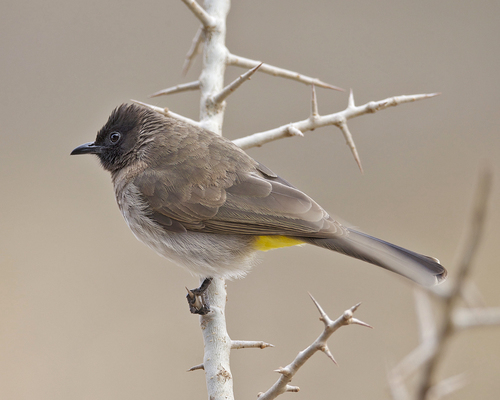
Common Bulbul
The Common Bulbul (Pycnonotus barbatus) is a ubiquitous and adaptable member of the bulbul family, found widely across Africa and parts of the Middle East. Known for its cheerful, fluid calls and often-conspicuous behavior, it plays a vital role in seed dispersal and insect control within its ecosystem. While not possessing striking plumage, its lively presence makes it a familiar sight in gardens, woodlands, and even urban areas. It holds a place in local folklore in some regions, often associated with good omens or representing resilience.
18-21 cm
Length
25-30 cm
Wingspan
Least Concern
Conservation Status
Distribution
Widespread across sub-Saharan Africa, extending north to the Maghreb and along the Nile Valley into Egypt. Also found in parts of the Arabian Peninsula, including Yemen and southwestern Saudi Arabia. It does not typically undertake long-distance migrations, although local movements in response to food availability may occur.
Lifespan
Typically 3-5 years in the wild, but can live longer in captivity (up to 10 years reported).
Common Bulbul's Habitat
Habitat Types
Forest edges, Woodlands, Savannas, Gardens, Cultivated areas, Urban parks
Climate Zones
Tropical, Subtropical, Temperate (in some coastal regions)
Adaptations
Highly adaptable to a variety of habitats, showing a tolerance for both humid and relatively dry conditions. Its generalist diet allows it to thrive in areas with diverse vegetation.
Variations
Several subspecies are recognized, differing slightly in plumage color and size, reflecting adaptations to local environmental conditions. For example, birds in drier regions tend to be paler.
Appearance
Breeding Plumage
Generally similar throughout the year.
Seasonal Feather Changes
Limited seasonal variation; may appear slightly duller after molting.
Sex Based Plumage Differences
Males and females are visually alike.
Notable Features
Dark brown upperparts, Pale greyish-white underparts, Blackish head with a slight crest, Yellow vent (undertail coverts)
Diet and Feeding
Primary Foods
Fruits, Berries, Insects, Nectar, Flower buds
Foraging Behavior
Forages actively in trees and shrubs, often in small groups. Will glean insects from leaves and branches, and pluck fruits directly from plants. Sometimes visits bird feeders.
Specializations
No highly specialized feeding adaptations; its generalist diet contributes to its adaptability.
Seasonal Diet Variations
Diet shifts with seasonal availability. May consume more insects during the breeding season to provide protein for chicks, and rely more on fruits at other times.
Behavior
Social Structure
Usually found in pairs or small family groups. May form larger flocks outside the breeding season, especially at abundant food sources.
Communication
Loud, liquid, and varied calls, Chattering and scolding notes, A distinctive 'pi-pi-pi-bulbul' call
Migration
Generally non-migratory, but may undertake local movements in response to food availability.
Territorial or Group Behaviors
Territorial during the breeding season, defending the area around the nest. Outside the breeding season, they are more tolerant of other bulbuls.
Conservation
Threats
Habitat loss (due to agriculture and urbanization), Pesticide use (affecting insect prey), Trapping for the cage-bird trade (in some regions)
Protection Programs
None specifically targeted at Common Bulbuls, but general habitat conservation efforts benefit the species.
Local National Laws
Protected under general bird protection laws in many countries, but enforcement may be limited.
Population Trend
Stable
Population Estimates
Widespread and abundant; population estimates are not precise, but the species is considered common across its range.
Interesting Facts
They are known for their bold and inquisitive nature.
Common Bulbuls often approach humans closely and are not easily intimidated.
They are important seed dispersers.
By consuming fruits and berries, they help to spread the seeds of many plant species.
They can become quite tame in gardens and parks.
They readily adapt to human presence and may become accustomed to feeding from bird tables.
Faqs about Common Bulbul
What is the lifespan of a Common Bulbul?
Typically 3-5 years in the wild, but they can live longer in captivity.
Are Common Bulbuls aggressive?
They can be territorial during the breeding season, but are generally not aggressive towards humans.
What do Common Bulbuls eat?
Their diet consists mainly of fruits, berries, insects, nectar, and flower buds.
Where can I see the Common Bulbul?
The Common Bulbul has a wide range across sub-Saharan Africa, parts of North Africa, and the Arabian Peninsula. It is common in gardens, woodlands, and even urban areas within its range.
Copyright @ Nature Style Limited. All Rights Reserved.
 English
English